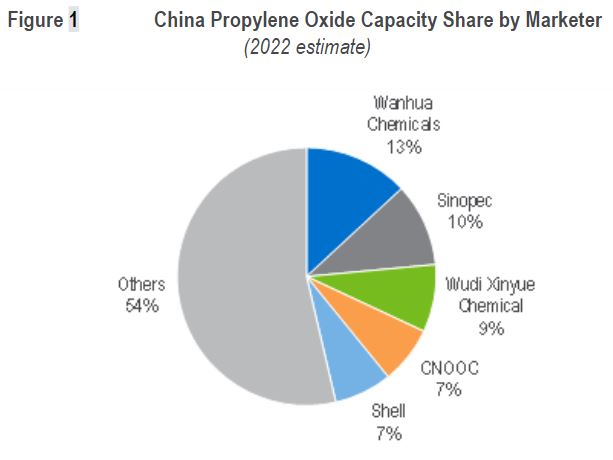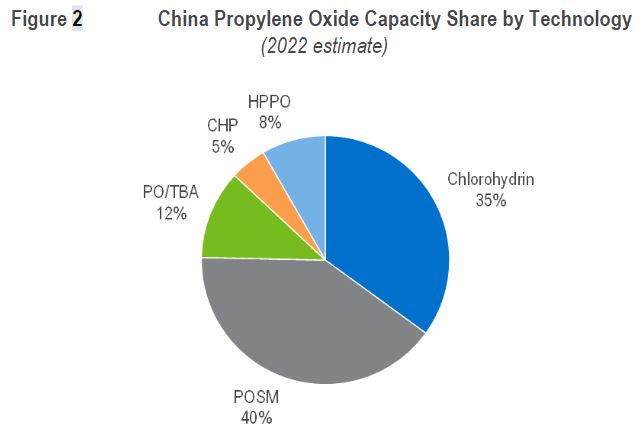Technological independence in China’s propylene oxide industry

Many products that we use in our daily lives, such as car seats, sofa cushions, mattresses, packaging foam, shoe soles, deicers, paints, cosmetics, detergents and pharmaceutical products are made using one important chemical intermediate – propylene oxide. Global demand for propylene oxide has grown by more than two percent annually in the past decade, spurred by growth in the various end-use sectors such as furniture, automotive, industrial, construction and household appliances etc.
Asia is the largest consuming region of propylene oxide, and hence it comes as no surprise that the region also has the largest propylene oxide capacity in the world, accounting for more than 40 percent of total global capacity. Within Asia, China is the largest propylene oxide producer where propylene oxide capacity has doubled in the past decade, driven by strong demand for downstream derivatives products. The top five propylene oxide producers in China are Wanhua Chemicals, Sinopec, Wudi Xinyue Chemical, CNOOC and Shell.
China Propylene Oxide Capacity Share by Marketer
Older Propylene Oxide Plants in China Mainly Based on Chlorohydrin Technology
More than one third of China’s propylene oxide capacity today is based on first generation chlorohydrin technology, where chlorine and a base (calcium hydroxide or sodium hydroxide) are used as key reagents to produce propylene oxide from propylene. The chlorohydrin process became the most prevalent route to produce propylene oxide during the 1970s as it required low investment costs, and there are no large quantities of co-products to market. Due to heightened environmental control by the Chinese government, construction of new chlorohydrin plants has been prohibited since 2015, and an increasing number of plant closures have been reported in recent years. Despite a capital cost advantage relative to other processes, chlorohydrin technology remains unfavorable due to environmental concerns from the chlorinated byproducts and the significant amount of wastewater generated.
Introduction of International Propylene Oxide Technologies into China
In 2006, China adopted for the first time an international propylene oxide production technology in the development of CNOOC Shell Petrochemicals Company’s (CSPC) 250 000 tons per year propylene oxide plant in Huizhou, Guangdong. This plant utilizes Shell’s Propylene Oxide Styrene Monomer (POSM) co-product technology, where propylene oxide and styrene are produced concurrently using ethylbenzene and propylene. In 2010 LyondellBasell’s POSM technology was licensed for the development of Zhenhai Refining’s 240 000 tons per year propylene oxide plant in Ningbo, Zhejiang.
Propylene Oxide/Tert-Butyl Alcohol (PO/TBA) technology was introduced in China in 2017 with the construction of Jinling Huntsman New Materials’ 240 000 tons per year propylene oxide plant in Nanjing, Jiangsu. The PO/TBA technology uses butane and propylene to produce propylene oxide, and the tert-butyl alcohol coproduct is used to produce MTBE in the process. This technology was originally licensed by Huntsman, but licensing rights have since been sold to Indorama Ventures (IVL) in 2020.
In the early 2000s, a relatively new technology, i.e. the Hydrogen Peroxide Propylene Oxide (HPPO) technology was making headlines in the global propylene oxide industry. The HPPO process involves the reaction of propylene with hydrogen peroxide to produce propylene oxide. This process is attractive as it has relatively lower energy requirements, and it produces water as the only byproduct. The HPPO technology was first brought into China by Evonik-Uhde in 2014 through the development of Jishen Chemical Industry’s 300 000 tons per year propylene oxide unit in Jilin province.
China Propylene Oxide Capacity Share by Technology
The Rise of Chinese Propylene Oxide Technologies
Over the past few years, there has been increasing scrutiny on the environmental impact of the refining and petrochemical industry in China. The country has ambitions to reach peak carbon emissions in 2030, which would see older, polluting refineries and chemical plants being phased out and replaced with green and low carbon facilities in the near term. Against the backdrop of U.S.- China tensions and global geopolitical uncertainty, China has also been seeking technological independence in strategic industries such as information technology, power equipment, medical devices etc.
Driven by the need to phase out older chlorohydrin plants in the country and reduce reliance on international technology licensors for new propylene oxide plants, several Chinese companies and institutions started developing their own propylene oxide production technologies in the past two decades. Chinese propylene oxide technologies are largely based on established technologies that have been developed by international licensors, with differences mainly in catalyst composition, reactor design and product purification sections.
Hongbaoli Group started up China’s first cumene hydroperoxidation (CHP)-based propylene oxide plant with a capacity of 120 000 tons per year in May 2019. The plant utilizes a CHP technology that was developed in-house. Hongbaoli Group offers technology licensing and process technology development for its CHP technology, as well as start-up guidance and operation training services.
In 2022, Wanhua Chemicals commercialized its proprietary POSM technology in the start-up of a 300 000 tons per year propylene oxide plant in Shandong province. The company recently announced a breakthrough in developing its own CHP technology since embarking on a pilot-scale study in 2014. Wanhua Chemicals will utilize its CHP technology in a new 400 000 tons per year propylene oxide plant in Shandong province that is expected to be completed in 2024. Once commissioned, Wanhua Chemicals will be the only propylene oxide producer in the world with plants utilizing three propylene oxide production technologies (i.e., POSM, PO/MTBE, and CHP processes) concurrently.
Sinopec, Tianchen Engineering, and Jiangsu Yida Chemicals have also dedicated R&D efforts into developing their own HPPO technologies, which have since been commercialized in existing and upcoming propylene oxide plants within China.
In 2015, Sinopec Changling Refinery started commercial operations of China’s first propylene oxide unit that employed domestic HPPO technology developed by Sinopec’s Research Institute of Petroleum Processing. The 100 000 tons per year propylene oxide unit has been running intermittently from 2015 to 2019 due to operational issues, but operations improved substantially in 2020. Between 2021 and 2022, Sinopec licensed its proprietary HPPO technology to two external parties – North Huajin United Refining and Petrochemical, and Zhejiang Yuanjin New Materials. The licensed units are part of integrated petrochemicals projects in China slated for completion after 2025.
Similar to Sinopec, Tianchen Engineering and Jiangsu Yida Chemical have also licensed their HPPO technologies to third parties for the construction of new propylene oxide plants in China. However, uncertainty surrounding plant reliability and product quality remains for the Chinese propylene oxide technologies as they have not been tested on a world scale over a significant operational period. In addition, none of these technologies have been adopted outside China to date. While it will take time for Chinese propylene oxide technologies to reach maturity and for the respective plants to achieve stable operating rates, Chinese licensors have definitely gained significant traction in the past few years towards achieving technology independence in the domestic propylene oxide industry.
Find out more…
Market Analytics: Propylene Oxide - 2022
This report provides analysis and forecasts to 2045 of supply and demand of the global propylene oxide market. Propylene oxide demand is segmented by polyether polyols, propylene glycol, glycol ethers and others. This analysis identifies the issues shaping the propylene oxide industry as well as provide detailed demand breakdown by end-use and supply, demand and net trade data for 40 countries.
TECH: Propylene Oxide (2022 Program)
This report provides an overview of the propylene oxide market, as well as conventional and emerging technologies for propylene oxide production. The report includes production cost estimates for six major commercial technologies in four different locations. An overview of the carbon intensity across three regions, the U.S., Western Europe and China for the propylene oxide technologies is also presented.
The Authors…
Jia Lin Chong, Consultant
Adam Chan, Managing Consultant

